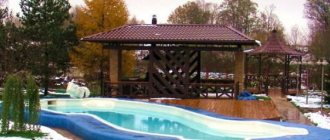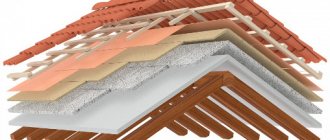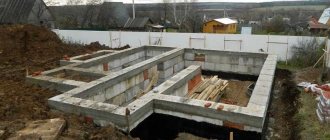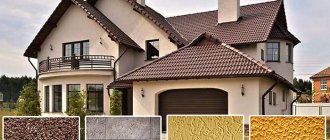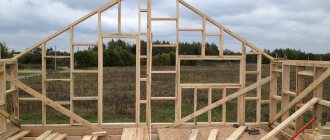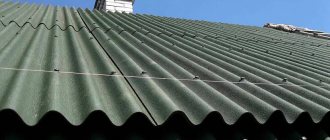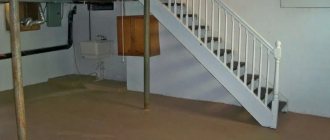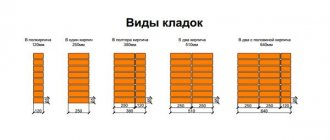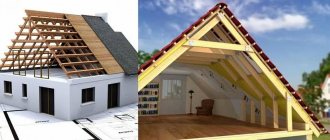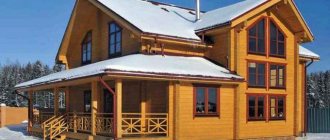Home / Installation, repair, maintenance / Insulation / How to insulate a slate roof from the inside?
Just a couple of decades ago, many houses had slate roofs. It was chosen for its low cost and relative ease of installation, while many of these roofs still serve today. However, there is often a need to insulate a roof under slate, and very few people know how to do this. In addition, when performing work to create a heat-insulating layer, many problems arise related to the characteristics of such roofing material as slate.
Insulating a slate roof from the inside - All about insulation and energy efficiency
The attic of a residential building is a spacious room that should not sit idle in vain. Many owners equip there a full-fledged living room, office, workshop, etc.
To do this, it is necessary to insulate the roof; cosmetic repairs alone will not do.
In addition, roof insulation reduces the overall heat loss of the house by 15% , which is quite noticeable. Technologically, this process is not too complicated, but it will require some knowledge.
Let's try to figure out what operations need to be performed to insulate the roof. If you are planning a living space under a roof, we recommend that you read the article on insulating an attic roof.
Main types of roof structures
Most often, in private housing construction, traditional gable roofs , as the most profitable option in our latitudes. They are effective both in summer rains and in winter snowfalls, have been tested for centuries and are quite reliable.
Preparatory stage
How to properly insulate a roof so that it lasts longer? The preparation and installation process may vary depending on the type of roof. Let's look at the preparation using the example of insulating pitched roofs using rolled materials. It is advisable to remove the roof, because... it will interfere with installation.
Check the attic for defects (cracks, mold, rot, inconsistencies, etc.) and eliminate them. If everything is “too neglected”, then it is recommended to completely rebuild the attic space, because... Even with good repair of defects, they will make themselves felt over time. Also, if any communications are laid through the roof, then they also need to be checked for damage and repaired.
Then install the support rails, on top of which the waterproofing layer and sheathing will be attached. They serve as support for the entire structure, so they must be strong enough. Because in most cases, the supports are made of wood; they also need to be treated with special materials to prevent moisture, fire and pests.
Insulating a slate roof
Tips for laying slate on a roof
It is recommended to use slate for roofing the flatst possible roofs with a minimum number of corners and various projections. The technology for installing slate coverings is simple and even novice craftsmen can do it.
The roof can be made from a flat one. and wave slate. Flat slate is recommended for roofs with a large slope.
But in any case, the geographical location of the region should be taken into account.
How to insulate a roof without removing slate: a simple method
Slate
- one of the most popular roofing materials, it has been used successfully for a long time and is not going to lose ground. Slate roofs are easy to insulate without removing the slate, but there are a few key points to be aware of.
Do-it-yourself roof insulation in a private house
Let's consider the process of insulating the roof of a house with your own hands in general terms. Detailed roof insulation technology is presented at the link.
- First you need to install a counter-lattice to ensure air movement in the under-roof space. This is a very important point and should not be neglected.
- The second step will be to strengthen the waterproofing on the counter-lattice. There are many types of waterproofing membranes or films; the use of one or another is dictated by the capabilities of the user.
- Next, a layer of insulation - mineral wool or expanded polystyrene, cut exactly to the size of the spaces between the rafters. The insulation can be temporarily held between the boards due to its own elasticity, but for reliability you can fasten it with fishing line, for which you need to hammer nails into the rafters.
- After strengthening the insulation, a layer of vapor barrier is applied. This is a film material that prevents the accumulation of condensation and wetting of the insulation. Glassine, polyethylene or polypropylene film are often used. The strips are attached to the rafters with a stapler and connected to each other with tape to achieve tightness.
- The last step will be tying with sheet materials to secure the “pie” and protect it from mechanical stress. As you can see, insulating the roof from the inside with your own hands (photo of the process below) is quite simple and does not require any special knowledge from you.
Algorithm for carrying out installation work
In order to insulate the roof from the inside with your own hands as efficiently , you need to carefully prepare - study topical articles and forums, watch training videos, consult with professionals. The work procedure itself can be divided into four stages:
You can do the work yourself
Main difficulties
Slate has a wavy shape and it will not be possible to lay the insulation close to its surface. This is one of the main problems, since creating a dense heat-insulating layer in this case will be difficult, especially when using fibrous insulating materials. It will be necessary to install a special system of cranial bars and sheathing so that the insulation has something to rest against during installation.
The second difficulty is waterproofing the heat-retaining material. The slate waves run along the entire plane of the roof and moist air easily enters them, which can render any fibrous insulation unusable - moisture can accumulate in them and the effectiveness of the material will decrease. Therefore, it is necessary to ensure high-quality waterproofing.
Previously, roofing felt was used as a water insulator, nailed directly to the roof sheathing before laying the slate. However, over time it very quickly becomes unusable and cannot serve as full protection against water. You will have to attach another layer of waterproofing materials to the rafters. It could even be a simple plastic film.
However, the question immediately arises of removing excess moisture from the insulating layer. It is necessary to secure the vapor barrier and waterproofing membrane in such a way that small ventilation channels are maintained between it and the roof, through which moist air will escape outside. Moreover, this must be done extremely carefully so as not to damage the protective film.
Choice of insulation
Having dealt with the protection of heat-retaining material, it is necessary to move on to one of the most important issues - the choice of insulation. It must be selected in accordance with the requirements that are placed on it. At the same time, in different cases these will be different requirements.
- For houses where residence is not permanent, a thin layer of material is sufficient - from 50 millimeters. It will retain heat while the house is being heated and will allow it to escape fairly quickly after the heaters are turned off or the furnace goes out.
- Permanent housing requires a different approach - you need to retain heat as efficiently as possible and the insulation layer should be at least 100 millimeters.
These data are true for a layer of mineral wool - the most popular and popular insulation. However, there are other options for insulating materials. For example - polystyrene foam. It is lightweight, easy to install and retains heat well. But, it also has enough disadvantages that will outweigh the advantages in the form of cheapness and lightness. This is a very flammable material that releases harmful substances when melting and burning. In addition, many people are allergic to the smell of polystyrene foam. So, it is suitable for technical structures, but it is better not to use it for housing.
Spray polyurethane foam can be an ideal solution for slate roofs. This is essentially a sprayed insulation that covers the entire treated surface with a dense layer, without cracks or gaps. When using it, it will only be necessary to ensure that there are no through cracks and holes in the roof and on the side of the gables. Its only drawback is the lack of air exchange between the external environment and the treated room. You'll have to think about good ventilation.
Another option for how to insulate a slate roof from the inside would be to use bulk insulation materials such as expanded clay, which are laid on the side of the ceiling that is external to the premises. This solution will not make the attic warm, but the insulation of living spaces will be very effective. The most modern material in this category will be ecowool, which can simply be scattered over the surface of the ceiling and covered from the outside with a waterproofing film.
Expanded polystyrene
Another popular insulation material is cheaper than mineral wool. However, it is a less flexible material, which makes it difficult to fill the entire space between the rafters. Therefore, you should be especially careful when choosing the sizes of polystyrene foam boards and their exact location.
There are two main types of polystyrene:
- EPS - polystyrene foam boards with a thermal conductivity coefficient of 0.030 - 0.042 W/(m*K),
- XPS – extruded polystyrene with a coefficient from 0.029 to 0.034 W/(m*K).
A steel grid is installed under the laid polystyrene foam slabs, and a second layer of expanded polystyrene is installed under the rafters to avoid thermal bridges.
Insulation of a roof that does not have counter-lattens and waterproofing
To secure the waterproofing membrane from the inside (from the attic side), you need two bars on each side of the rafter leg and one in the middle between the rafters.
The first pair of bars is attached to the rafters close to the roofing, the central bar is attached parallel to them to the sheathing - they are responsible for creating a ventilation gap between the membrane and the roof. It is necessary to ensure the flow of air into this space through the eaves overhang.
The thickness of the block can be 3-5 cm and should be sufficient to “hold” the fasteners - these are just spacer strips. And the width of the bar is chosen based on the requirements for the size of the air gap, so this size should not be less than 4 cm.
After installing the spacer strips, a waterproofing membrane is laid between the rafters. In a standard situation, it is laid over the rafters from the bottom up in horizontal strips with overlapping joints; here the installation is carried out “vertically” - one strip between each pair of rafters.
Insulation of a roof that does not have a counter-lattice, but has a vapor barrier
The difference between this version of the roofing pie device is that if the roof leaks, water will not get onto the insulation. In addition, if the vapor barrier has an anti-condensation surface, then it will “bind” part of the condensate that forms when the atmospheric air cools.
But this condensation, just like excess moisture in the insulation, must be ventilated from the under-roof space. And for this you need a conro-lattice with a vertical ventilation gap.
In this case, the waterproofing membrane can be attached a little easier than in the previous case:
- Between each pair of rafters, parallel to them, three or four slats are placed (depending on the distance between the rafter legs). The thickness of the rail is chosen equal to the size of the air gap (usually 4-5 cm).
- A waterproofing membrane is laid between the rafters. It can be laid either in one strip vertically or in pieces of panels horizontally with the top panel overlapping the bottom by 15-20 cm (installation must be done from top to bottom).
- The waterproofing membrane is stapled to each batten and along the rafter legs.
Thermal insulation material and vapor barrier are laid using standard technology.
Insulation of the U-shaped attic contour
If the roof is high and the area of the house is large, then the attic can be equipped without sloping walls - with a U-shaped contour, the thermal insulation of which will not come into contact with the roof.
In this case, behind the contour of the attic there will be an ordinary cold attic with its own ventilation through the eaves and ridge vents. In essence, this is a technology for insulating a frame house, but inside the attic.
Insulating the attic ceiling:
- Boards or slats of the rough ceiling are hemmed to the top ties, which act as ceiling beams.
- A vapor barrier is installed on the side of the room. The strips are laid overlapping and all joints are glued.
- On the “attic” side of the attic, insulation is laid between the tie beams (if necessary, in two layers).
- A waterproofing membrane is spread over the insulation. It is required if it is not included in the roofing pie. If the roof has waterproofing, but the mineral wool mats are not laminated, then ordinary fiberglass can be laid on them as a wind barrier.
- On the inside, a counter-lattice is attached over the vapor barrier. It is needed to ensure that there is an air gap necessary for the functioning of a vapor barrier with an anti-condensation or reflective surface.
Insulation of attic walls:
- A waterproofing windproof membrane is attached to the outside of the posts.
- If the contour of the attic on the roof side is sheathed with plywood or OSB, counter-lattice bars are nailed to the posts on top of the waterproofing.
- Thermal insulation is laid between the racks.
- A vapor barrier is laid in a continuous layer on the inside of the racks. Tape the junction with the vapor barrier of the ceiling and floor.
- Install the sheathing for the interior lining.
If none of the options suits you, then the roof can be dismantled, and waterproofing and insulation can be carried out using standard technology.
RECOMMENDATIONS FOR SOLVING THE PROBLEM OF CONDENSATION IN A COLD ATTIC
Based on the home inspection, the customer was given the following recommendations:
1. It is necessary to ensure good ventilation of the entire volume of the attic room with outside air. To do this, it is possible to use one of two schemes for organizing air flows in a cold attic:
Schemes for organizing cold attic ventilation
In the diagram: a) – attic ventilation through dormer windows; b) – attic ventilation through eaves and ridge vents.
The best option for attic ventilation is ventilation scheme “b” - through vents in the roof eaves and at the ridge. But, in the absence of the technical ability to organize such products, a fairly effective measure would be the implementation of scheme “a”, i.e. installation of dormer windows on four roof slopes on all sides of the horizon. And if the house had a simple gable roof, then it would be enough to install ventilation windows on two opposite gables of the roof.
Variants of dormer window shapes (in ventilation scheme “a”)
In Fig.: 1 - Gable; 2 - Single slope; 3 - Valmovoe; 4 - Arched; 5 - Triangular; 6 - Arched with a pediment in the plane of the facade.
Options for exhaust ducts in the ridge part of the roof (in ventilation scheme “b”)
In the figure: a) – ridge slot hood; b) – point exhaust using ridge aerators.
In any of the above options, the optimal area of the ventilation ducts should be 1/300 of the attic area, but not less than 1/500. Thus, for example, with an attic area of 120 sq.m., the area of the ventilation ducts through which outside air enters the attic should be in the range from 0.24 sq.m. (2400 sq.cm) to 0.4 sq.m. (4000 sq.cm).
2. It is necessary to ensure complete airtightness of the attic staircase hatch in order to prevent the penetration of warm, humid internal air from the premises of the house into the attic.
3. It is necessary to insulate the attic ladder hatch from the attic side in order to avoid freezing of the hatch and, as a result, condensation on its inner surface facing the premises of the house.
The insulation of the hatch can be carried out according to the design of an exit to the attic in the form of a thermally insulated cabin with a door into the attic volume, or according to the design of a thermally insulated box with a horizontal lid.
4. It is necessary to clear the attic space of construction debris and material residues to ensure maximum circulation of ventilation air throughout the entire volume of the attic and avoid stagnant zones.
The results of a similar inspection of a cold attic, carried out by SЌРєСЃРїРµСЂС‚ами Акадомиииииииииииииииииииииииииииииват‚ РІ холодноРј S‡РµСЂРґР°РєРµ».
<< назад к списку
Which side should you put the slate on?
The surface of the slate sheet is different on both sides. On one side it is more corrugated, on the other side it is smooth. When laying slate on a roof, the smooth side should be on top.
This is necessary so that snow can easily roll off the roof in winter and not create blockages, which can lead to water leaking through the overlaps.
It is necessary to calculate the number of sheets of slate required for covering, taking into account the overlap, both horizontally and vertically.
You need to start laying slate on the side opposite to the prevailing winds in the region.
During normal installation, on each sheet of slate, except for the outer ones, two corners located diagonally are cut off in order to reduce the thickness of the overlap.
When laying offset, when the next horizontal row is shifted by half the width of the slate sheet, this is not necessary.
Selection of tools
Roofing tools
The ideal option would be to purchase a special professional long knife . It is made taking into account the requirements placed on it - made of carbon steel with a length of 35 cm and a comfortable handle made of high-quality plastic.
In addition to a good cutting tool, you will definitely need a hammer, a screwdriver, self-tapping screws of different lengths, a long strong cord, reliable protective clothing, glasses to preserve your vision and a respirator.
It would also be a good idea to listen to the following recommendations:
Cutting mineral wool
Useful tips
If the attic appears to be a large and cold room, you can use various types of insulation, after which you can live in this room. Thermal insulation material can be laid both during the construction of the roof and after that. If the roof is already covered with slate or other material, then the work is done from the inside, which changes the arrangement of the layers during the installation of insulation.
When working with glass wool, it is necessary to use protective equipment to prevent glass particles from getting into your eyes or nose. The choice of modern materials is not always the most acceptable, if only because of their high cost.
The correct procedure for laying all layers will allow anyone, even a non-professional, to insulate a room.
What to choose as insulation
The classic material is mineral wool,
suitable in most cases. It is inconvenient for transportation, as it stains the car interior, can generate dust and cause coughing. However, there are other materials, such as polystyrene foam. It is cheap, easy to transport and install. It is very light, so it is easy to work with in the attic, it is easy to lift such panels up and fasten them.
Expanded polystyrene panels can be transported on the roof or trunk of a car. There are also disadvantages: the material causes allergies, so it is not suitable for everyone. In case of fire, it releases toxic substances and is itself very flammable and flammable. It is usually used for offices and industrial premises, but is not recommended for apartments.
You can also find other types of insulation on sale, which are more expensive, but have their own advantages.
Recently, an advanced method has appeared - sprayed polyurethane foam
. This is a sprayable material that fills all the cracks and reliably seals the roof. The disadvantage is that it interferes with ventilation, and the owners of the premises will have to think about how to ventilate the room and remove moisture from it.
How to insulate a turnkey slate roof
Even if you hired a specialist for such work, you will be interested to know how the installation of thermal insulation of a slate roof goes:
- first you need to conduct a thorough inspection of the roof to find all the cracks;
- after this it is necessary to seal the cracks. If this is not done, then thermal insulation will be ineffective;
- it is necessary to treat all beams with special solutions that destroy fungus and mold;
- Now you can start installing the insulation. Mineral wool or expanded polystyrene work well for a slate roof;
- When all the thermal insulation work is completed, you can start finishing and painting the ceiling.
Insulating a slate roof is not a very complicated process. However, if you want modern insulation, leave the job to an experienced professional.
Physical factors: impact
Any house that is used for housing must meet certain requirements to make living in it cozy and comfortable. It is important to lay the foundation correctly so that the house does not shrink or crack, insulate it and build a roof. The choice of covering is very important because it determines the weight that is applied to the house, the time it takes to complete the covering work and the cost. In addition to all this, it is necessary to take care of insulating the inside of the roof so that the structure of the house remains as reliable as possible and the residents feel comfortable at any time of the year.
In different climatic conditions, buildings are affected by various factors.
Our latitudes will be characterized by:
- precipitation in the form of rain;
- snow, cereals and similar phenomena;
- hail;
- roof icing;
- active sun;
- strong wind.
To withstand all these negative factors, the roof must be covered with sufficiently dense materials that can reliably protect the house for many years.
A private house is a structure that consists of a main floor and an attic. If the roof is not insulated, then up to 15% of the heat from the room escapes through the ceiling in cold weather, which makes it necessary to intensively heat the rooms. In addition, having an insulated attic, this space can, if desired, be made residential and used as rooms for a specific purpose. For a large family this is an ideal option.
Processes inside
In order to properly insulate a private house and make the roof a full-fledged protective mechanism for both the main room and the attic, you need to be able to choose the right material for insulation. Usually the selection is based on the physical processes occurring inside, under the roof.
There are several of the most important ones.
- Heat exchange , which occurs due to different temperatures in the house and outside it. If the roof is not insulated, then some of the heat escapes through the roof, and the insulation prevents this process and maintains optimal temperature in the room.
- Moisture exchange , which occurs from the person himself, his breath, evaporation from body temperature to the cooking processes, when vapor rises to the ceiling, carrying particles of moisture that are removed through the roof. If the roof is insulated, the humidity level remains optimal, and unnecessary odors can be removed using ventilation.
The main mistakes when insulating a roof
Actions that can negate all your work and expenses:
Almost all private households located in most regions of the country roof insulation from the inside Therefore, such events should not be postponed “for later”. It is better to carry out thermal insulation at the construction stage of the building. Properly organized roof insulation is the key to comfortable living in the house and a noticeable reduction in energy costs.
Necessity or whim?
A private home often has a pitched roof that creates an attic space on top of the main living floor. If there is no insulation, then living in such conditions will be very uncomfortable due to the lack of heat during the cold season. If the attic is designed as a residential floor - the same attic, then the insulation process must be mandatory.
Any roofing material cannot protect as much as polystyrene foam, mineral wool or another type of coating. In addition to the insulation itself, it is important to use a vapor barrier film that can cope with various types of fumes.
If you ignore the installation of an insulating coating, then in addition to the cold in the house, very soon problems will begin with the roof rafter system , which will rot and there will be a risk of collapse. The same effect can be observed with incorrect installation technology or inaccurate choice of insulation. If you choose the wrong thickness of the insulation, then instead of protection it will have the opposite effect. Under normal conditions, when there is a difference in temperature, protection is provided against condensation and heat loss, which makes it possible to feel comfortable in any weather.
If the thickness is compromised and thin insulation is selected, then an excessively large amount of condensation will form on it, which will contribute to rapid rotting of the rafters and disruption of the microclimate of the room.
Failure to comply with the standards is dangerous for both health and safety , since the roof structure may collapse. The choice of material that needs to be insulated depends on a wide variety of factors that are important to consider in order to be able to independently install what is needed. If difficulties arise with the choice of insulation or its installation, it is better to contact professionals and receive comprehensive advice and assistance in installation.
Roof “pie”: what is it like?
A properly constructed roof involves a large number of layers of different materials that are layered on top of each other, resembling a pie - hence the name. The basis of the construction “pie” is the rafters, on which all other layers are already being laid.
To correctly lay out all the layers, it is important to know their correct sequence, which looks like this:
- Roof.
- The lathing on which the finishing materials will be installed. It can be laid completely or with gaps.
- A counter-lattice in the form of bars, which serves to ventilate the space under the roof itself.
- Film for waterproofing.
- Materials for thermal insulation.
- A layer of vapor barrier material.
- Creating a sheathing where insulating materials and internal lining are mounted.
- Material for internal lining.
If you lay the “pie” correctly, you can avoid heat loss from the living space during the cold season, and it will also help prevent the space from overheating in extreme heat. The waterproofing layer will help protect the insulation from moisture coming from outside, and the vapor barrier layer will protect against various types of fumes.
A pitched roof is a fairly common type , so it will not be difficult to select all the necessary materials for it. The positive aspect of high attics is the convenience of insulating them and the ability to create a full-fledged living space.
Without additional work, it will be extremely unpleasant to be in it - it is very cold in winter, and too hot in summer.
Requirements for materials and their functions
To carry out quality work, it is necessary to choose the right materials. It will depend on them how accurately it will be possible to create comfortable living conditions and secure the roof supports. The choice will depend on the region where the building is located, its size, purpose, as well as the funds available to purchase materials.
There are four main methods of insulation.
- Using mineral wool , which is the most commonly used material due to its properties. It is best to purchase the basalt variety. It is advisable to obtain a quality certificate from the store in order to know for sure that the products are safe and meet all norms and standards. There are varieties that are lighter in weight; they are suitable for working in conditions of independent insulation of the room. The positive qualities of cotton wool can be considered non-flammable composition and moisture repellence, which corresponds to the main task of this layer. In addition, rodents do not like it, which means you don’t have to worry about someone getting in the house, especially on the roof.
Among the disadvantages, one can note the rather high cost, but it is fully compensated by the positive aspects.
- Use of glass wool. Some time ago, this material was considered the main one for roof insulation, but due to some dangerous properties, safer analogues were soon found. The thermal insulation of glass wool is quite good, and the efficiency is very high. When working with such material, it is very important to follow all safety rules, namely, use a protective suit, gloves, and goggles. It is important to close your nasopharynx and eyes to prevent pieces of glass dust from getting into them.
People with allergies will not be able to live in such a house, so you need to be able to choose the right type of internal insulation coating.
- Polymer roof insulation consists of special tiles made of polystyrene foam and expanded polystyrene. They have both advantages and disadvantages. This is an inexpensive option, so anyone can afford it, but if you look at the disadvantages, you should think carefully about purchasing such insulation. These materials are very flammable, and when burned they produce a large amount of smoke, which is very dangerous to humans.
Usually this type is used when other options cannot be used.
- Insulation with expanded clay. This material is very often used for floor insulation and has good thermal insulation properties, but it is very difficult to use for roofs due to heavy installation. Usually only experienced workers can handle it to make internal insulation of the ceiling in the house.
If we consider alternative options, among them are polyurethane foam, which can be used in two states - in the form of slabs and foam. It is advisable not to take slabs for arranging the ceiling, because working with them is inconvenient and they are very expensive. At the same time, liquid or foamed polyurethane is easy to apply and has a number of advantages. With its help, you can fill voids of any shape and size; cracks and opening lines are very well clogged. If other materials need to be cut and achieved maximum fit, then in this case the foam will fall on its own, the main thing is to distribute it correctly and evenly.
It is very convenient to use foam for roofing made of slate or broken structures when there are many differences on the roof and the frame has significant differences. Another significant advantage is the independence from hydro- and thermal insulation, which are not needed for polyurethane foam. In addition, the material has excellent flammability resistance, which ensures home safety.
Technologies
How to properly repair a slate roof. Slate roof maintenance.
How to properly repair a slate roof
DISASSEMBLY OF SLEATE
If the roof is severely damaged, you need to completely replace the old covering with a new one.
Tools needed to dismantle the roof:
- Pliers (for removing old nails);
- Walking bridge(s), in order to calmly move along the roof without fear of damage;
- Grinder for cutting pieces of slate;
- Hammer, nails, screwdriver;
- Roof ridge caps.
The process of replacing the old coating with a new one occurs according to the same scheme as installing the roof, but in the reverse order. First you need to remove the nails that secure the slate to the roof.
In order to remove old slate, you need at least 4 people: two on the roof and two below. Two people take the slate at the edges and feed it down, those remaining at the bottom take one slate and carefully place it on the ground. If the material is unsuitable, it can be thrown off the roof without fear of damage. If it can be used for any purpose, then additional hands are needed to remove it from the roof.
When removing slate from the roof, you must follow safety regulations. If handled carelessly, it may fall from a height and cause damage to property or endanger human life. People who cannot maintain balance and who are afraid of heights should not attempt to replace slate themselves. It is better in this situation to resort to the help of specialists. Never forget about safety precautions! You cannot dismantle the roof while intoxicated.
!It is necessary to assess the condition of the rafters. If they are in poor condition, then it is better to replace them with new ones.
!To ensure the roof is sealed, you need to lay roofing material or other material on it and insulate the roof, if necessary.
MAINTENANCE OF A SLATE ROOF
Slate roof repairs won't take long if you carefully monitor the condition of the roof. In addition, it is necessary to remove dry branches from trees growing in the immediate vicinity of the house, as well as branches hanging over the roof.
The fight against mosses and lichens involves mechanical or chemical cleaning of the affected areas. In the first case, a brush with metal bristles is used. After stripping, the coating is washed with water and treated with a primer, which will seal the open pores on the surface of the chrysothiocement sheets and prevent the reappearance of unwanted vegetation.
The chemical cleaning method involves the use of special products containing alkalis, acids or surfactants. Processing is carried out according to the manufacturer's instructions. Protective equipment is mandatory.
The durability and reliability of the roofing structure and finishing coating depends largely on the quality of their care during operation. It is advisable to conduct an annual (twice a year - in spring and autumn) thorough inspection of the structure and roofing and effective, timely repair of identified damage. When removing snow from a slate roof, use only wooden shovels. It is not recommended to walk directly on roofs made of chrysotile cement corrugated sheets. Work to clear roofs of debris and snow should be carried out using portable stepladders.
